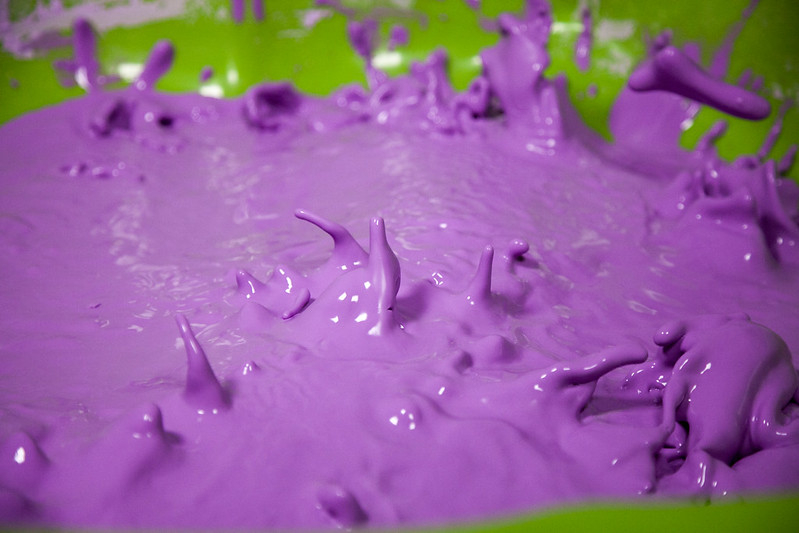Difference Between Newtonian and Non Newtonian Fluids
Table of Contents
The key difference between Newtonian and non Newtonian fluids is that Newtonian fluids have a constant viscosity, whereas non-Newtonian fluids have a variable viscosity.
We can divide fluids, i.e. liquids and gases, as either Newtonian or non-Newtonian depending on the viscosity of the fluid. Viscosity is the state of being thick and sticky due to the internal friction of the fluid. Furthermore, we need to consider other parameters in determining whether a fluid is Newtonian or non-Newtonian. These are shear stress and shear rate. Shear stress is the stress applied coplanar on the fluid cross-section while shear rate is the rate of change of velocity at which one layer of fluid passes over an adjacent layer.
CONTENTS
1. Overview and Key Difference
2. What is Newtonian Fluid
3. What is Non Newtonian Fluid
4. Side by Side Comparison – Newtonian vs Non Newtonian Fluids in Tabular Form
5. Summary
What is Newtonian Fluid?
Newtonian fluids are fluids having a constant viscosity and a zero shear rate at zero shear stress. That means; the shear rate is directly proportional to shear stress. In other words, the ratio of the shear stress to the shear rate is constant throughout the fluid.

Figure 01: Characteristics of a Newtonian Fluid
However, most fluids we know have a variable viscosity. Usually, no real fluids fit the definition exactly. Therefore, it is considered as a simple mathematical model. But we can assume some common liquids and gases such as water and air as Newtonian fluids. The name Newtonian comes from Isaac Newton, who was the first scientist to use a differential equation to postulate the relationship between shear stress and shear rate of fluids.
What is Non Newtonian Fluid?
Non-Newtonian fluids are the fluids that have a variable viscosity and a variable relationship with shear stress. It is because these fluids do not follow Newton’s law of viscosity. The viscosity of these fluids can change under force. i.e. some liquids such as sauce are runnier when the bottle is shaken. Most fluids we know are non-Newtonian fluids. Many salt solutions, molten polymers and many other fluids can be categorized into this group.

Figure 02: A Non-Newtonian Fluid
Although we use the term viscosity in fluid mechanics to describe the shear properties of a fluid, it is not adequate to describe the properties of non-Newtonian fluids. There are different behavioural characteristics of non-Newtonian fluids including viscoelasticity, time-dependent viscosity, etc.
What is the Difference Between Newtonian and Non Newtonian Fluids?
Fluids can be classified into two types depending on the viscosity as Newtonian fluids and non-Newtonian fluids. The key difference between Newtonian and non Newtonian fluids is that the Newtonian fluids have a constant viscosity, whereas the non-Newtonian fluids have a variable viscosity. Furthermore, when considering the shear rate and shear stress, in Newtonian fluids, we can observe a zero shear rate at zero shear stress. That means; the shear rate is directly proportional to the shear stress. However, non-Newtonian fluids have a variable relationship between shear rate and shear stress.
Although most fluids we know are non-Newtonian fluids, water and air are considered as Newtonian fluids at normal conditions. However, almost all salts, molten polymer material, blood, toothpaste, paint, corn starch and many other varieties of fluids are non-Newtonian fluids.
The below infographic summarizes the difference between Newtonian and non Newtonian fluids.

Summary – Newtonian vs Non Newtonian Fluids
Fluids can be classified into two types depending on the viscosity as Newtonian fluids and non-Newtonian fluids. The key difference between Newtonian and non Newtonian fluids is that Newtonian fluids have a constant viscosity, whereas non-Newtonian fluids have a variable viscosity.
Reference:
1. Coussot, P. “Introduction to the Rheology of Complex Fluids.” Understanding the Rheology of Concrete, 2012, pp. 3–22., doi:10.1533/9780857095282.1.3.
2. “Newtonian Fluid.” Wikipedia, Wikimedia Foundation, 13 Oct. 2019, Available here.
3. “Non-Newtonian Fluid.” Wikipedia, Wikimedia Foundation, 8 Sept. 2019, Available here.
Image Courtesy:
1. “Dilatant-pseudoplastic” By DirectEON (talk) 08:46, 28 March 2008 (UTC) – self-made (CC BY-SA 3.0) via Commons Wikimedia
2. “paddling pool cornstarch 9” By Trevor Cox (CC BY-SA 2.0) via Flickr
ncG1vNJzZmivp6x7pbXFn5yrnZ6YsqOx07CcnqZemLyue8OinZ%2Bdopq7pLGMm5ytr5Wau266xLCrqKaZlrturc2dZKennmK7psPTqKWimZ5is63ByJ2qaA%3D%3D